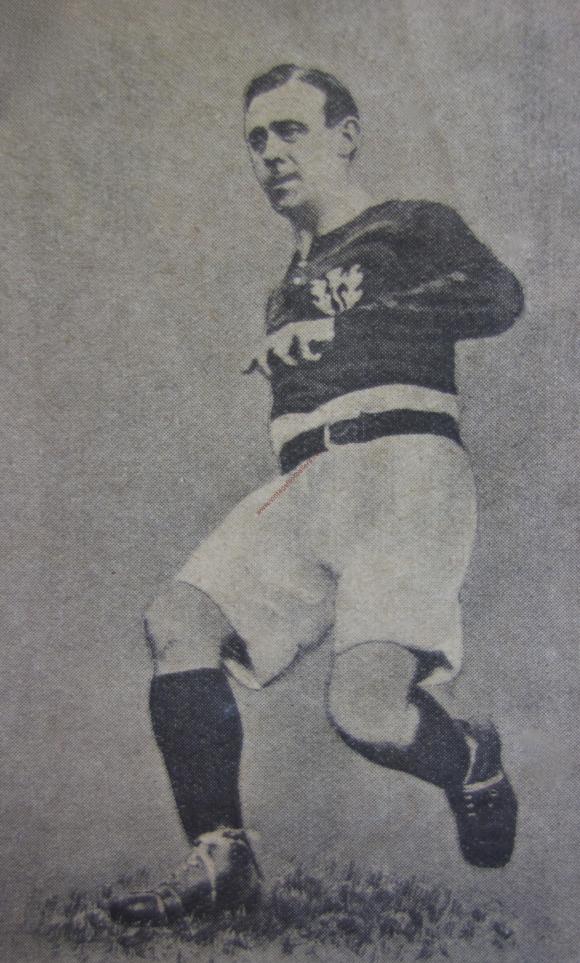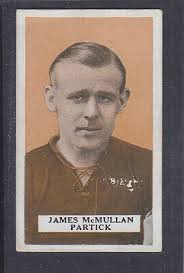By Marc Wallace (@MarcJWallace)
Manchester City and Partick Thistle are worlds apart these days – but as the centenary of Thistle’s greatest day comes around – one man played an integral role in the success of both clubs – even though he missed out on the Thistle cup win through injury.
That man was Jimmy McMullan. He was born on March 26 1895 in Denny, Stirlingshire. Though the town would produce several prominent names in several fields – including the pioneer of the Liquid Crystal Display [LCD], George William Gray and other prominent footballers of various eras from 1950’s Derby County and Dundee legend Billy Steel, and a name known to those with a more modern knowledge of Scottish football lower down the pyramid in Kenny Deuchar.
Onto the man himself, he began he began his career at Denny Hibernian, a local junior side before he moved to Glasgow, signing for Third Lanark in 1912, a season in which Thirds managed a 15th place finish in the top flight – finishing above Raith Rovers, Partick Thistle [funnily enough] and Queen’s Park – the latter of whom avoided relegation that year due to a vote.
A move to Thistle followed and McMullan established himself both with the Jags and also in the then similar colours of Scotland, becoming Scotland’s greatest half-back of the era. Playing on the left hand side a precursor to the modern Left Wing-Back and a more defensive version of the Left-Back itself.

Thistle would finish 15th in Jimmy’s first season with the club but the Jags would finish in seventh in 1914-15 and then sixth a season after that, football by that time [1915-16] was really beginning to be affected by the war and the league began to change – owing to transportation difficulties as sides such as Dundee, Raith Rovers and Aberdeen were removed from the league – the official line being they were asked to retire from league play and also no Scottish Cup was played – instead local regional cups took precedence.
Thistle would lose the Glasgow Cup final in 1914-15 after a replay to Clyde, they would reach the final again in 1917-18 but lost 4-1 to Rangers.
Again, Thistle were developing well in this period, a sixth-place finish in 1918 was followed by a fourth-place finish in 1919 but they fell back to mid-table mediocrity in 1920 with a 13th place finish.
Then came 1920-21, Jimmy would win his first official cap for Scotland, a long time in coming, as he had turned out for both England and Scotland in wartime competition as well as playing four times for the Scottish League XI.
His debut came on February 26th, 1920 at Ninian Park against Wales – Scotland would rescue a draw with a late goal from Tommy Cairns.
Scotland narrowly missed out on the 1920 British Championship, finishing as runners up to the Welsh. Scotland defeated Ireland 3-0 but crucially lost 5-4 to England at Hillsborough to miss out.
In 1921 there was to be none of the same heartache as Scotland, with Jimmy ever-present in their side, swept to victory, taking home the title. A 2-1 victory over Wales was followed by a 2-0 win in front of a 40,000 crowd at Windsor Park over Ireland and glory would follow on April the 9th with a 3-0 victory over England.
But that was to be all for Jimmy in this season in which both he and Thistle reached the highest of highs as a mystery injury led to him being omitted from the Scottish Cup final squad against Rangers.
That final was set against the backdrop of controversy, it was played at the time of a miner’s strike and also saw a record-low attendance of under 30,000 people at Celtic Park – dubbed the Boycott Final – this reduced gate was due to the SFA increasing the admission price which put off already hard-up punters in the early years after the war.
As alluded to, that victory over England would be Jimmy’s last appearance in Scotland for some time, with ambitions to play in England, he was displeased when Thistle rejected an offer of £5,000 [£246,373 in 2020] for him from Newcastle United and he chose to leave to become the player-manager of Maidstone United.
Jimmy’s stay in England wasn’t terribly long and he was back at Thistle in the summer of 1923 and was soon back to excelling for the Jags and for Scotland, helping Scotland collect another British title in 1925 before getting his [well deserved] big move to England – joining Manchester City for £4,700 in 1926.

While this is mainly about Jimmy’s time at Thistle it wouldn’t be fair to not talk about the absolute peak of Jimmy’s career – even if it came at City and that was on March 31st 1928.
Jimmy was captain of Scotland as they faced England at Wembley, though not a vintage year as Wales had already secured the glory and this match was to determine the wooden spoon, as it were.
But under Jimmy’s leadership Scotland were ruthless, tearing England apart with a hat-trick from right-winger, Alex Jackson of Huddersfield Town, and a brace from Preston North End inside-left, Alex James.
Any disappointment from not collecting the trophy that year was short-lived as Jimmy captained Scotland to victory the following year.
Jimmy’s legacy is literally set in stone in Manchester as a street in Manchester’s Moss Side where their Maine Road ground stood was named after him. Among the others receiving the honour at the time were Eric Brook – who stood as City’s record goal scorer until modern times when he was surpassed by Sergio Aguero.
Jimmy McMullan died on November 30th 1964 at the age of 69. He enjoyed a career that won him honours for club and country. In 1934 he was appointed as the first-ever official manager of Aston Villa. His managerial career also took him to Notts County, Oldham Athletic and Sheffield Wednesday.
